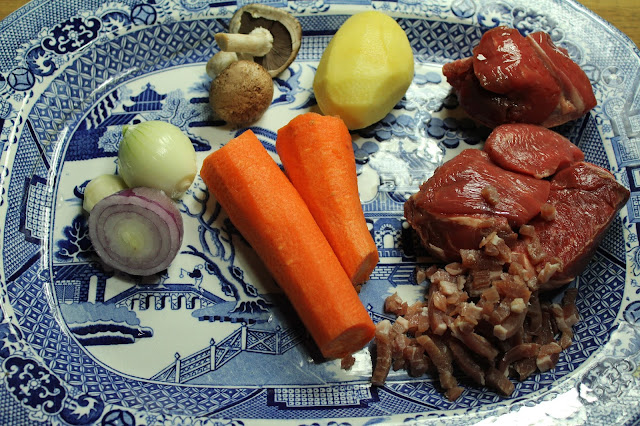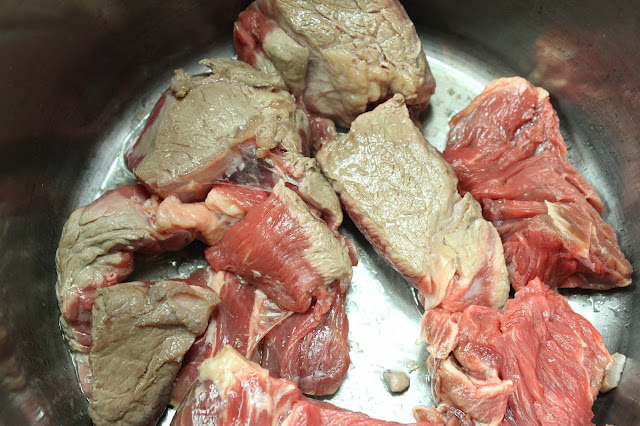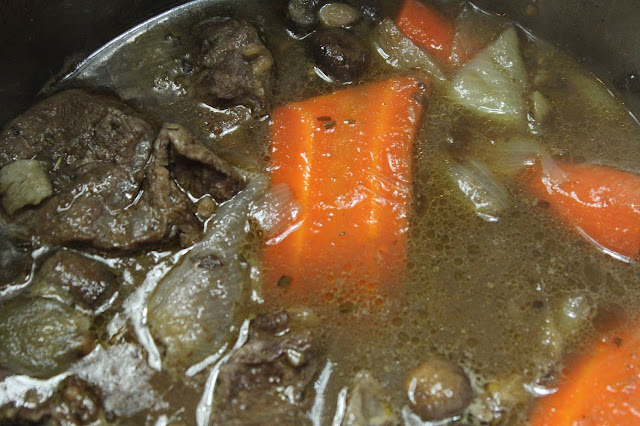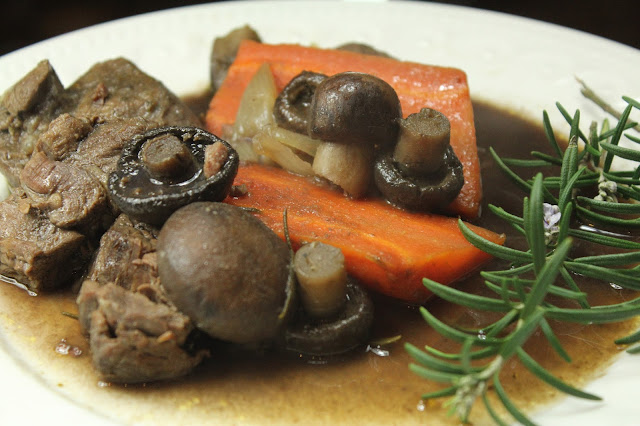The term literally means 'in the fashion of Burgundy', which Larousse Gastronomique, describes as:
'...the region of France where the best food is to be had and it enjoys the esteem of gastronomes for the quality and variety of its wines.'
There are probably well over 50,000,000 French people who would disagree with that, including all my neighbours here in Basse Normandie who think our region has the best food in France but would concur with the following, as Larousse continues:
'a method of preparation called à la bourguignonne , used mainly for large cuts of braised meat, also for eggs, fish and poultry , a red wine sauce with a garnish of mushrooms and small onions.'I use potato not flour for thickening, so this dish is gluten-free. The recipe makes enough for 2 people for 3 days if you keep adding vegetables.
Ingredients
1½ lbs - 680g of beef (see ideas for cuts below)
3½oz - 100g of lardons, fat bacon chopped into small chunks or allumettes (matchsticks)
15 mushrooms (the older the better)
15 small pearl onions or 3 -4 larger ones chopped into chunks
5 - 6 large carrots halved but not chopped
1 large or 2 medium potatoes for thickening the stock
garlic ( couple of large whole cloves just flattened with the blade of the knife)
1 glass (Paris goblet) of red wine (see below)
2 - 3 pints 1½ litres plus of stock or enough to cover the ingredients (see below)
2 sticks of fresh rosemary
Dried herbs (I use a mix known as herbes de provence)
Sea salt
Ideas for the wine
The original wine for this dish is red Burgundy made from the pinot noir grape but I'm just using what I have to hand which is a Spanish tempranillo, a grape which has the same medium to full-bodied characteristics needed for this rich beef dish. Please note that I got this wine from a store that sells off end of bins, very cheaply, this bottle of Musso cost under $2 but it is not a 'cheap' wine. Ignore any mischievous imposter who tells you that you can use any old cheap wine in cooking, you can't, you will just ruin your precious ingredients. Always taste your wine first. It is better to leave it out of the recipe altogether, if you are not completely satisfied with it because bad wine gets even worse when you cook with it!Traditional cuts of meat
This dish is not an everyday sort of dish like pot au feu, which is made with the very cheapest beef. It is traditionally made with Top Rump (and according to my Larousse, marinated in brandy for 6 hours) but my butcher, whom I trust, chose 'Collier' for this dish and I have made it with this cut many times and it never disappoints. As the French name suggests this is the piece of meat from the area where a collar would be worn. Like all good organic meat it is slow grown, from grass-fed cattle and very dense, so really suitable for slow cooking at lower temperatures and great for this type of one pot stew. We make quite a large amount at a time and thus will eat it over several days and it actually gets better and better every day.The wonders of home-made stock
The pan I am using to make this dish is my stock pot. It is a heavy stainless steel pan which is permanently on our stove and its contents form the basis of many of the stews, soups and sauces we make on a daily basis. You can of course buy your stock but you will never achieve that richness in your dishes that a home-made variety will provide. A typical stock will contain all the goodness from the bones, remains and previous cooking stock of braised meats, their accompanying vegetables and bones and residues from roasts. The stock I'm using here, for example, is enriched with the bones and remainders from: a ham hock and breast of lamb, the ghost of the roast leg of lamb we ate for Christmas, the carcass of a roast guinea fowl and a roast chicken or two. I started this idea of a traditional stock pot two years ago when my husband had a couple of really bad muscle injuries and needed to build back collagen, it meant he could have a cup of hot nourishing soup, throughout the day and we could use it to cook everything we normally boiled, braised or stewed. Well we fixed his muscle problem but then went on to keep the stock pot, realising that actually everything tasted so much better.
My French butcher presumes that my not being French means I know nothing about cooking meat and has actually given me loads of tips and a lot of free fat/lard/beef tallow, so I'm not complaining. One I'll share here is; don't cut meat into little cubes/chunks when you are making this dish or in fact any stew or similar. The meat is so much better left in large portions.
Firstly sauté the meat lightly on both sides in butter or beef lard/tallow.
Add the lardons/bacon and sauté them too.
Remove the pan from the heat and add half the wine.
Add all the rest of the ingredients finishing with the rosemary, then sprinkling the dried herbs and finally adding the stock.
Just add enough stock to cover the ingredients. Any left over can be added later if needed or used to cook the additional vegetables for the next day(s).
Simmer gently on a low heat (do not boil) for as long as possible until the meat is tender (around 3 hours) Check from time to time to see if more stock is needed.
Around 5 - 10 minutes before the end of cooking add the rest of the wine.
Serve straight from the pan into a deep dish, with plenty of stock and eat as a soup
or
Serve on a plate with some sauteed potatoes and/or rice and of course a glass of red.
To follow, a perfect foil would be a green salad with a little blue cheese incorporated.
Bon Appétit!
All the very best,
Sue
© Sue Cross 2021
More Main Course Ideas
Piperade The Taste of the Sun from South West France GLUTEN-FREE
Butternut Squash Stuffed & Roasted Optional Topping GLUTEN-FREE
It's that time of year again, the days are getting shorter, the hens are going to roost earlier and you've got that yen for sitting around the fire and curling up around a hot cocoa, a delicious supper dish and a Gothic novel, preferably by Sheridan Le Fanu. On a stormy night I'd suggest..read moreCornish Pasty With Potato Pastry Gluten-free
Mining started in Devon and Cornwall in the Bronze age around 4,000 years ago. Once a world leader in tin production, in its heyday, Cornwall boasted 2,000 tin mines. It also had copper mines and in the 18th century the area..read more














No comments:
Post a Comment